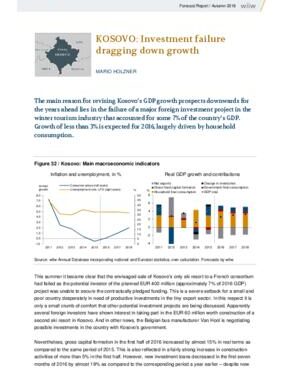Kosovo’s economy demonstrated steady growth in the first quarter of the year, with the country’s gross domestic product (GDP) expanding by 3.6% year-on-year, according to the latest data reported by SeeNews. This positive trend underscores ongoing economic resilience amid regional and global uncertainties, reflecting increased activity across key sectors. The growth rate marks a significant indicator of Kosovo’s continued efforts toward economic development and stability.
Kosovo’s Economic Expansion Driven by Strong Domestic Demand
The recent expansion in Kosovo’s economy is primarily attributed to robust domestic consumption, which has significantly bolstered growth in the first quarter. Household spending surged, supported by rising wages and increased employment opportunities, driving demand across various sectors. Key industries such as retail, construction, and manufacturing reported higher activity levels, reflecting a positive consumer sentiment and confidence in financial stability. Additionally, government initiatives aimed at stimulating the local market through infrastructure investments and social programs have further fueled internal demand.
Economic analysts highlight several factors underpinning this domestic-driven growth:
- Higher disposable income due to wage growth and remittances.
- Improved credit availability encouraging consumer and business spending.
- Targeted government expenditures enhancing public services and infrastructure.
| Sector | Growth Rate Q1 (%) | Contribution to GDP (%) |
|---|---|---|
| Retail Trade | 5.1 | 1.2 |
| Construction | 4.7 | 0.8 |
| Manufacturing | 3.3 | 0.6 |
| Services | 3.9 | 1.0 |
Key Sectors Fueling Growth and Their Impact on Employment Rates
Several key sectors have been instrumental in driving Kosovo’s robust economic expansion this quarter. The manufacturing industry, primarily focused on textiles and metal processing, has seen a remarkable uptick driven by increased foreign investment and improved supply chain efficiencies. Additionally, the services sector, particularly information technology and telecommunications, continues to expand rapidly, benefiting from an influx of skilled labor and government incentives promoting digital infrastructure. Agriculture also remains a steady contributor, with increased output in produce and livestock aiding rural employment and sustained economic activity outside urban centers.
This growth in core industries has directly influenced employment rates across the country. The rise in industrial output has translated into significant job creation, with new positions emerging in both entry-level and skilled trades. The tech sector’s expansion has brought higher-paying jobs, boosting disposable income and consumer spending. Below is a summary of employment changes by sector during Q1:
| Sector | Employment Growth (%) | New Jobs Created |
|---|---|---|
| Manufacturing | 5.2% | 8,500 |
| Services (IT & Telecom) | 7.8% | 6,200 |
| Agriculture | 2.1% | 3,100 |
| Construction | 4.3% | 4,700 |
Policy Recommendations to Sustain Momentum and Attract Foreign Investment
To ensure sustained economic growth and enhance Kosovo’s attractiveness to foreign investors, strategic reforms are essential. Prioritizing regulatory transparency and streamlining administrative procedures will significantly reduce bureaucratic hurdles, fostering a more business-friendly environment. Additionally, strengthening legal frameworks, particularly in property rights and contract enforcement, can build investor confidence. Encouraging public-private partnerships in infrastructure development will not only accelerate project completion but also demonstrate Kosovo’s commitment to a modernized economy.
Key initiatives to drive investment include:
- Implementing tax incentives targeted at high-potential sectors such as technology, manufacturing, and renewable energy.
- Enhancing workforce skills through vocational training aligned with market needs.
- Expanding digital infrastructure to facilitate innovation and cross-border commerce.
- Creating dedicated investment zones with streamlined permits and support services.
| Policy Area | Impact | Timeline |
|---|---|---|
| Regulatory Reform | Faster business registration | 6-12 months |
| Tax Incentives | Increased FDI inflows | Ongoing |
| Workforce Development | Improved labor productivity | 12-24 months |
| Digital Infrastructure | Boosted innovation | 12-18 months |
Final Thoughts
In summary, Kosovo’s 3.6% year-on-year GDP growth in the first quarter underscores the country’s ongoing economic resilience amid regional and global challenges. As the government continues to implement reforms and attract investment, analysts will be closely monitoring whether this positive momentum can be sustained throughout the remainder of the year. Further developments will be key to assessing Kosovo’s trajectory towards greater economic stability and growth.














![Poland and France push ahead with defense pact after Paris talks [VIDEO] – TVP World](https://europ.info/wp-content/uploads/2026/01/3036754-poland-and-france-push-ahead-with-defense-pact-after-paris-talks-video-tvp-world-120x86.jpg)

